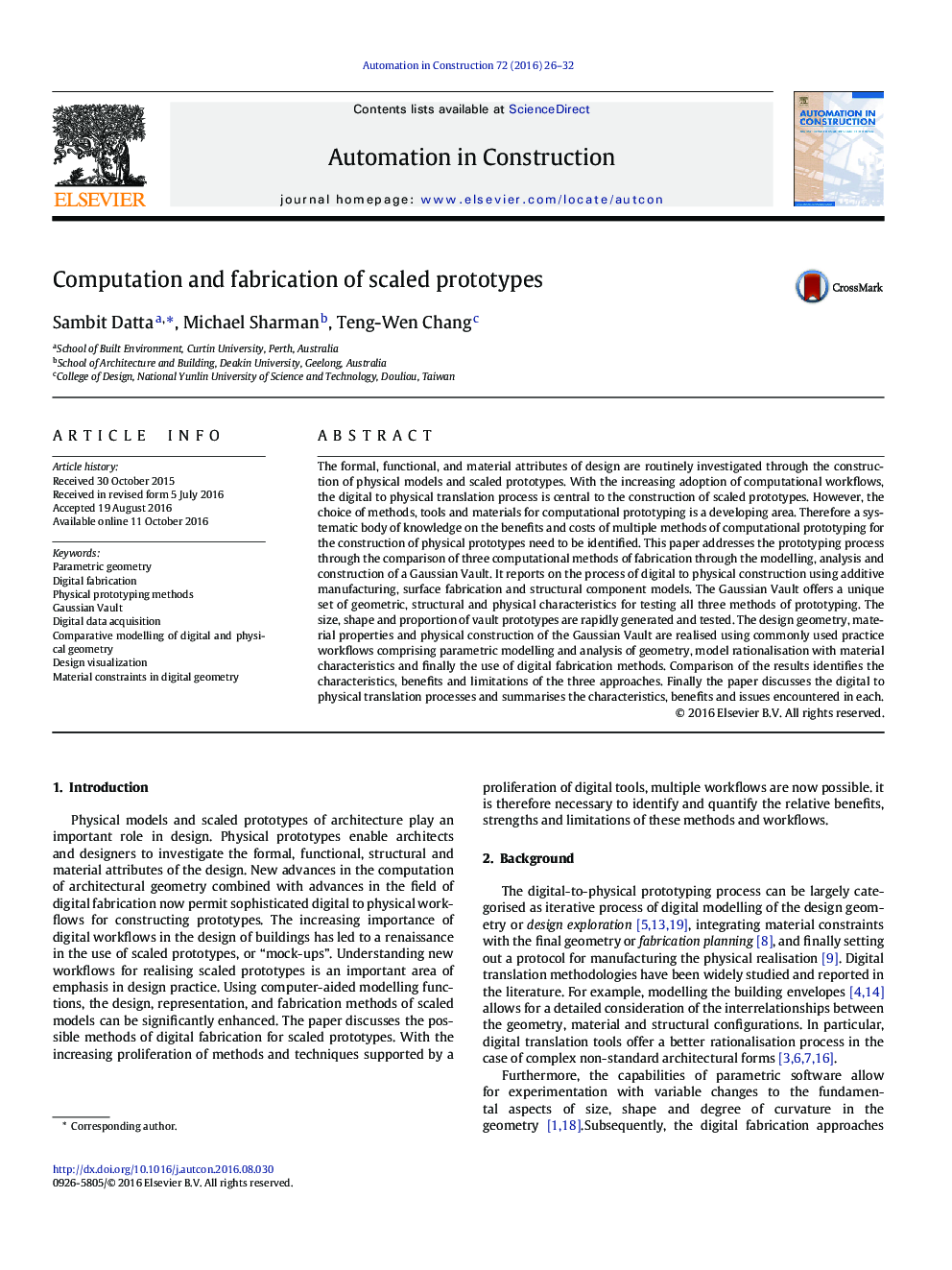| کد مقاله | کد نشریه | سال انتشار | مقاله انگلیسی | نسخه تمام متن |
|---|---|---|---|---|
| 4911391 | 1362758 | 2016 | 7 صفحه PDF | دانلود رایگان |
عنوان انگلیسی مقاله ISI
Computation and fabrication of scaled prototypes
ترجمه فارسی عنوان
محاسبه و ساخت نمونه های مقیاس پذیر
دانلود مقاله + سفارش ترجمه
دانلود مقاله ISI انگلیسی
رایگان برای ایرانیان
کلمات کلیدی
هندسه پارامتریک، ساخت دیجیتال، روش های نمونه سازی فیزیکی، غار گاوس، گرفتن اطلاعات دیجیتال، مدلسازی مقایسه ای از هندسه دیجیتال و فیزیکی، تجسم طراحی، محدودیت های مواد در هندسه دیجیتال،
ترجمه چکیده
ویژگی های رسمی، کاربردی و مادی طراحی به طور مرتب از طریق ساخت مدل های فیزیکی و نمونه های مقیاس شناخته می شود. با اتخاذ فزایندهای از جریانهای محاسباتی، فرایند ترجمه دیجیتال به فیزیکی، ساختن نمونههای مقیاسپذیر است. با این حال، انتخاب روشها، ابزارها و مواد اولیه برای نمونه سازی محاسباتی یک منطقه در حال توسعه است. بنابراین باید یک سیستم اطلاعاتی جامع از مزایا و هزینه های چندین روش نمونه سازی محاسباتی برای ساخت نمونه های فیزیکی شناسایی شود. این مقاله فرایند نمونه برداری را از طریق مقایسه سه روش محاسبه ساخت از طریق مدل سازی، تجزیه و تحلیل و ساخت یک خلیج گاوس می پردازد. این گزارش در مورد روند ساخت دیجیتال به فیزیک با استفاده از تولید افزودنی، ساخت سطح و مدل های ساختاری ساختار گزارش می شود. خلیج گاوس مجموعه ای منحصر به فرد از ویژگی های هندسی، ساختاری و فیزیکی را برای آزمایش تمامی سه روش نمونه سازی ارائه می کند. اندازه، شکل و نسبت نمونه های غرفه به سرعت تولید و آزمایش می شود. هندسه طراحی، خواص مواد و ساختار فیزیکی خزانه گاوس با استفاده از روشهای معمول کارآمدی عمل می کنند که شامل مدل سازی پارامتری و تجزیه و تحلیل هندسه، تصحیح مدل با ویژگی های مواد و در نهایت استفاده از روش های ساخت دیجیتال است. مقایسه نتایج، ویژگی ها، مزایا و محدودیت های این سه رویکرد را مشخص می کند. در نهایت مقاله در مورد فرایندهای ترجمه دیجیتال فیزیکی بحث می کند و ویژگی ها، مزایا و مسائل را در هر کدام خلاصه می کند.
موضوعات مرتبط
مهندسی و علوم پایه
سایر رشته های مهندسی
مهندسی عمران و سازه
چکیده انگلیسی
The formal, functional, and material attributes of design are routinely investigated through the construction of physical models and scaled prototypes. With the increasing adoption of computational workflows, the digital to physical translation process is central to the construction of scaled prototypes. However, the choice of methods, tools and materials for computational prototyping is a developing area. Therefore a systematic body of knowledge on the benefits and costs of multiple methods of computational prototyping for the construction of physical prototypes need to be identified. This paper addresses the prototyping process through the comparison of three computational methods of fabrication through the modelling, analysis and construction of a Gaussian Vault. It reports on the process of digital to physical construction using additive manufacturing, surface fabrication and structural component models. The Gaussian Vault offers a unique set of geometric, structural and physical characteristics for testing all three methods of prototyping. The size, shape and proportion of vault prototypes are rapidly generated and tested. The design geometry, material properties and physical construction of the Gaussian Vault are realised using commonly used practice workflows comprising parametric modelling and analysis of geometry, model rationalisation with material characteristics and finally the use of digital fabrication methods. Comparison of the results identifies the characteristics, benefits and limitations of the three approaches. Finally the paper discusses the digital to physical translation processes and summarises the characteristics, benefits and issues encountered in each.
ناشر
Database: Elsevier - ScienceDirect (ساینس دایرکت)
Journal: Automation in Construction - Volume 72, Part 1, December 2016, Pages 26-32
Journal: Automation in Construction - Volume 72, Part 1, December 2016, Pages 26-32
نویسندگان
Sambit Datta, Michael Sharman, Teng-Wen Chang,
